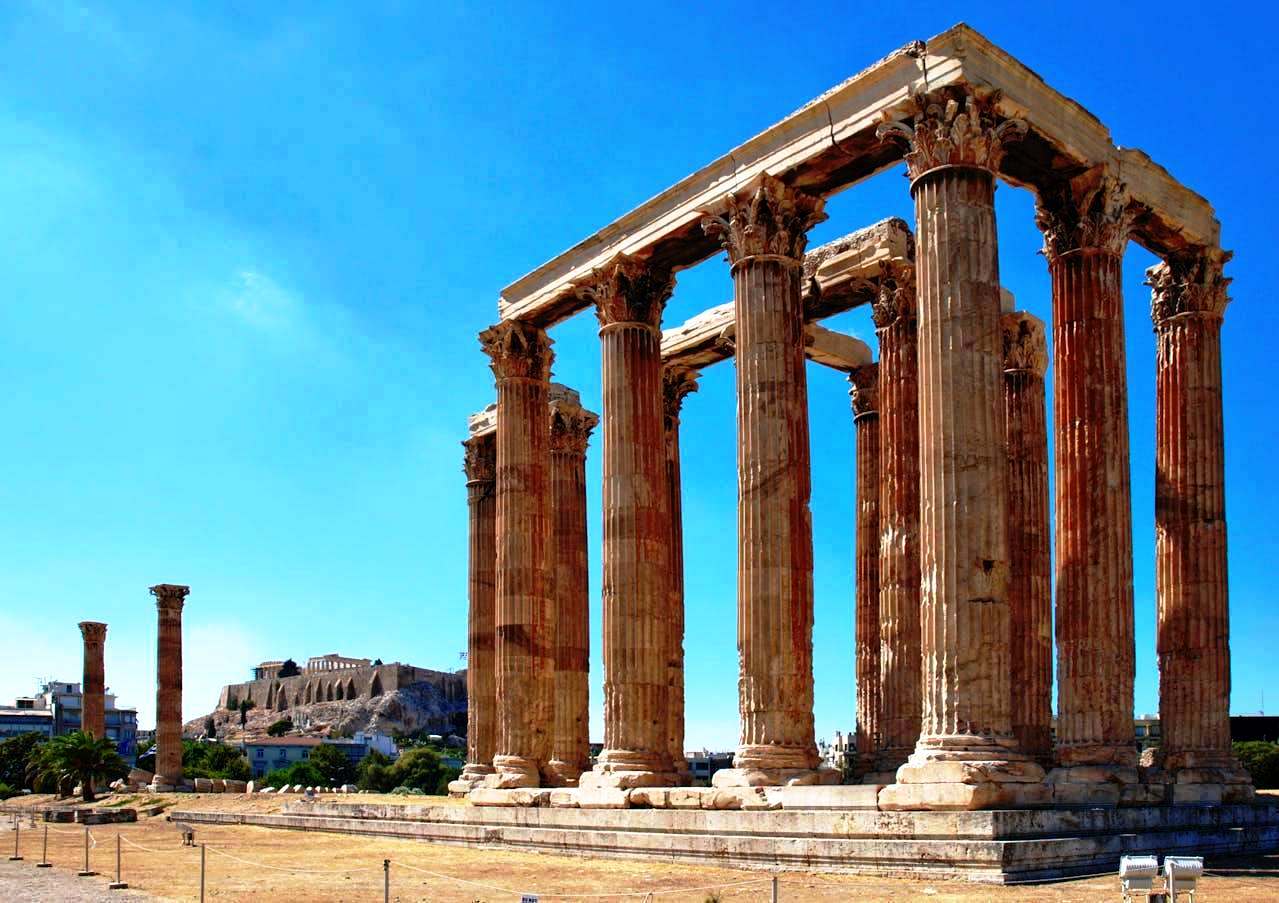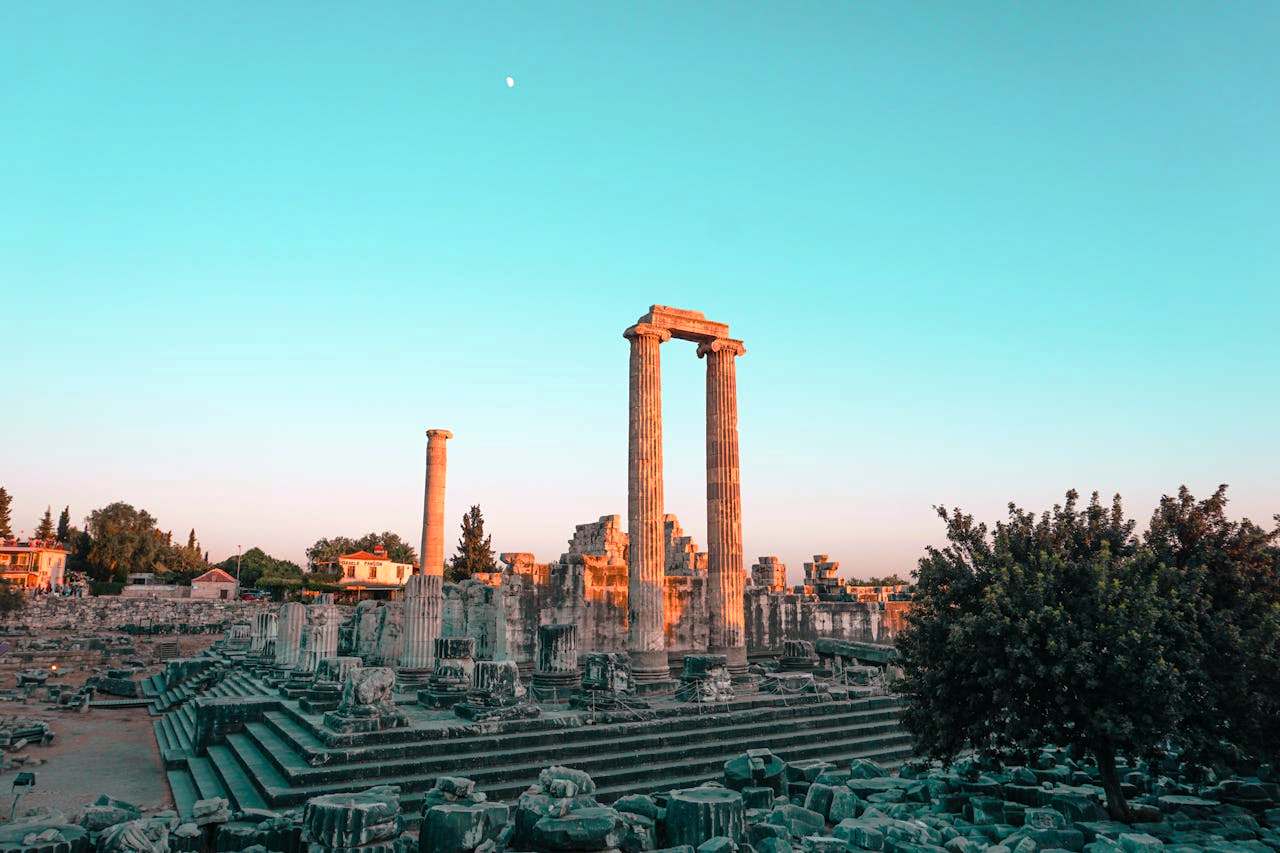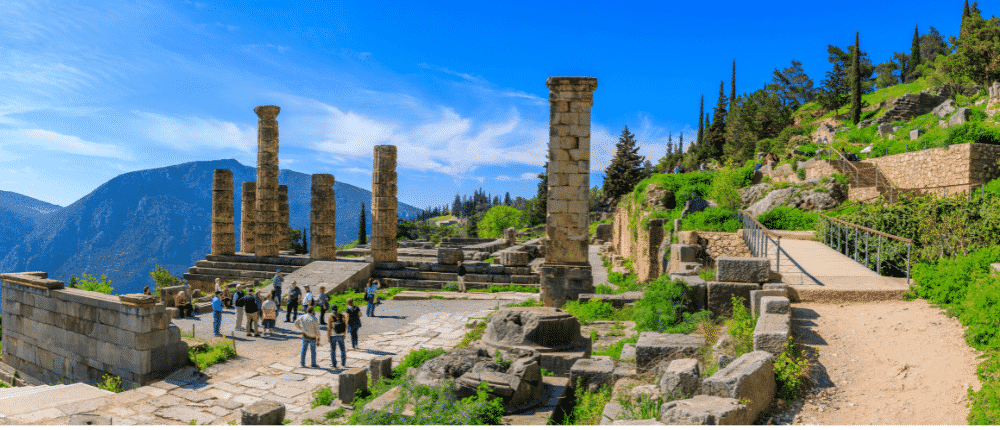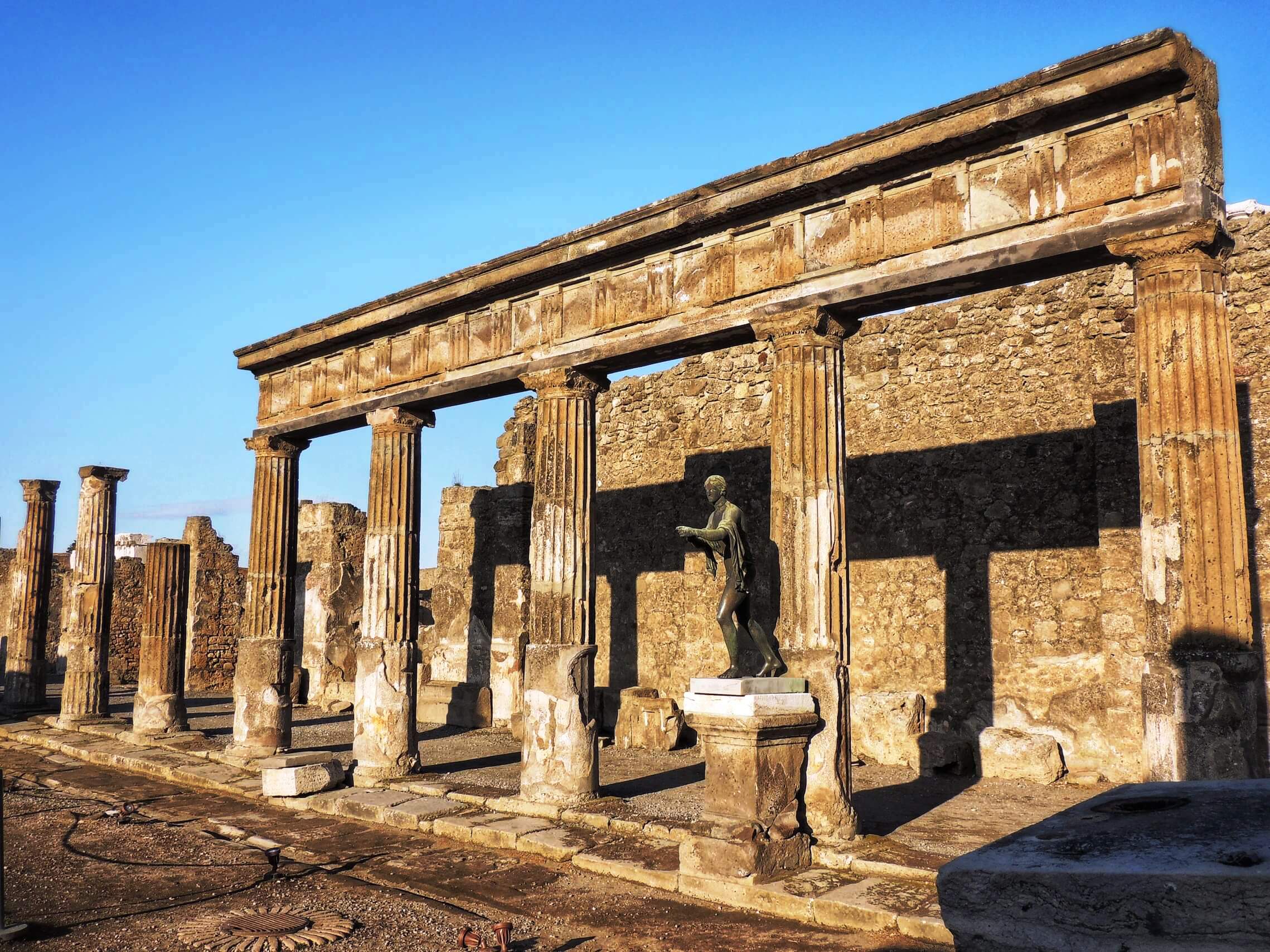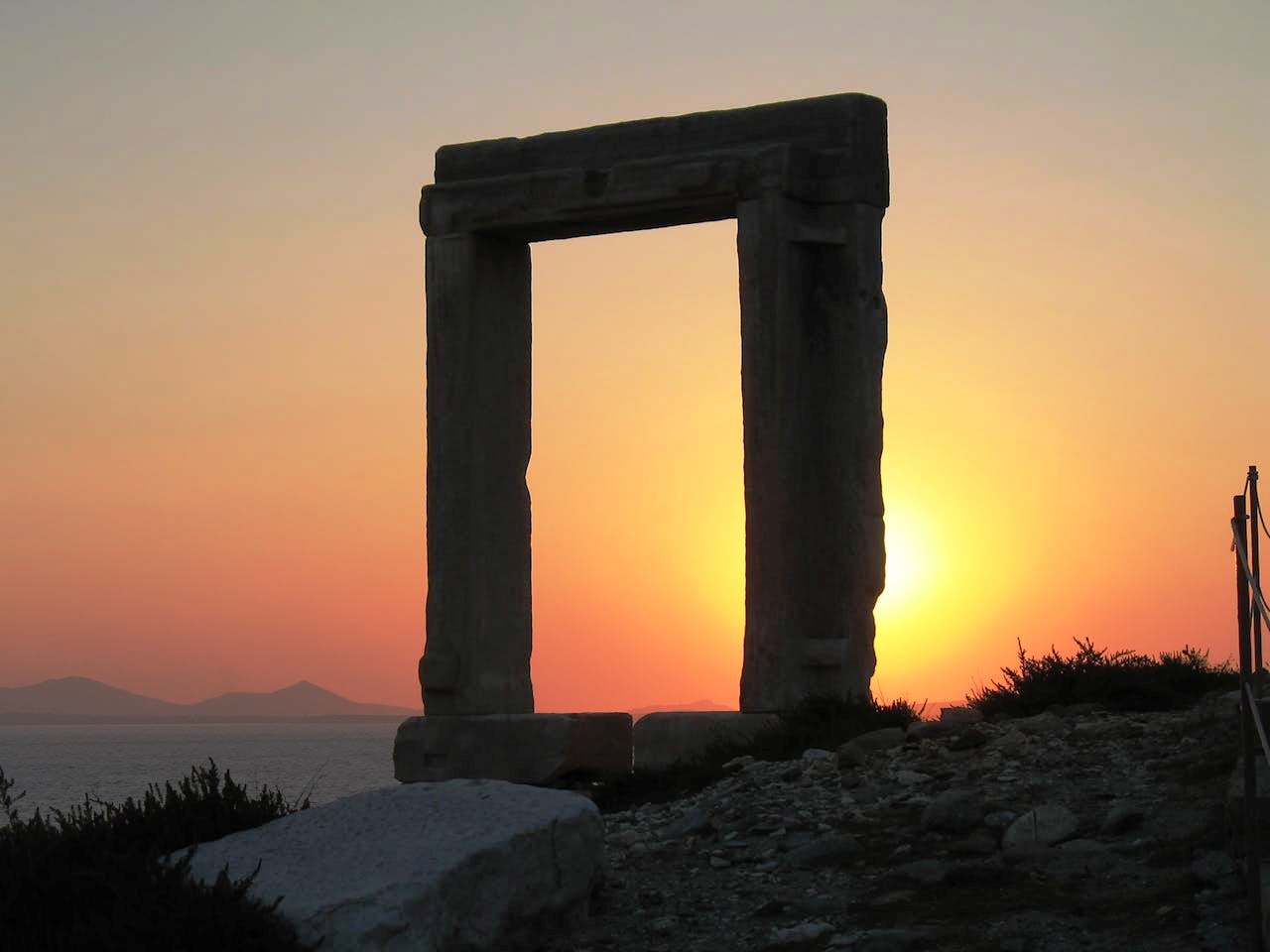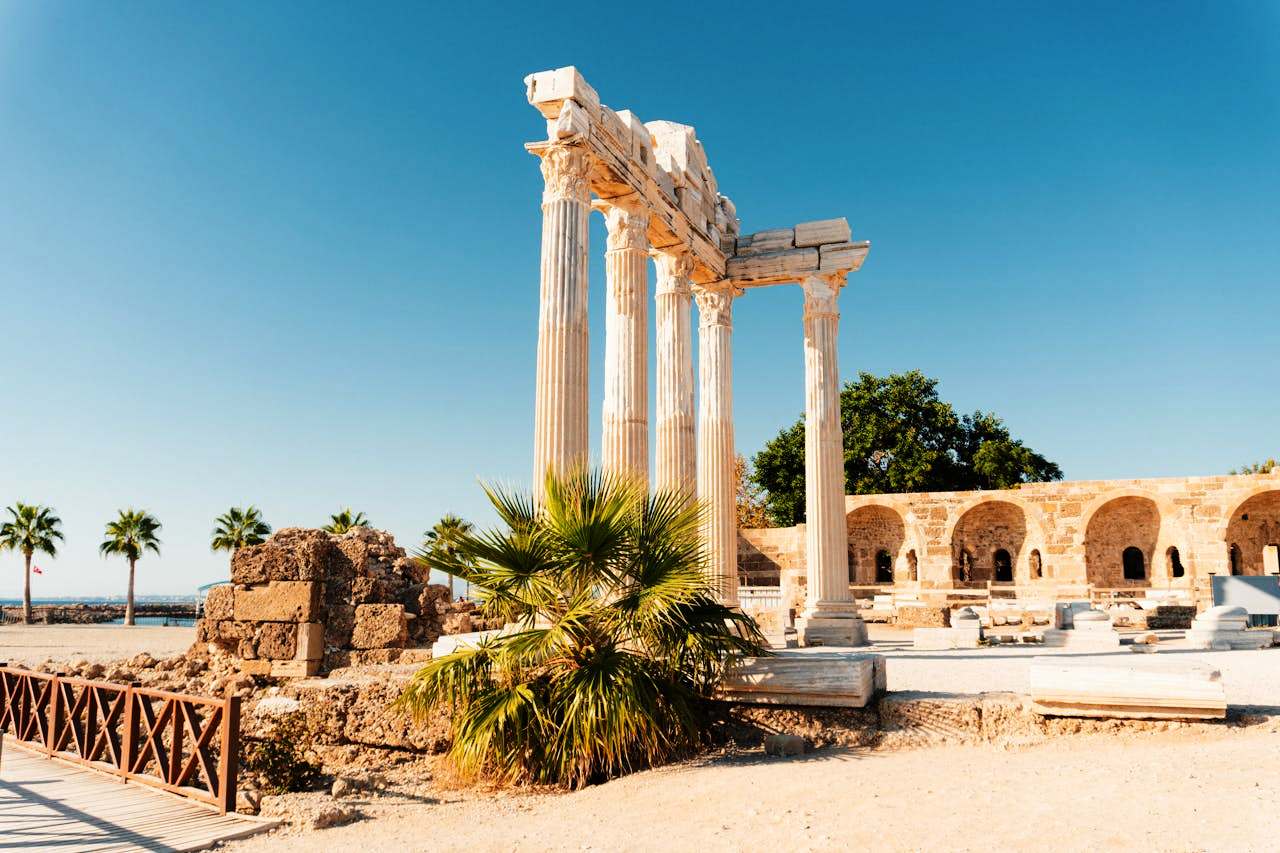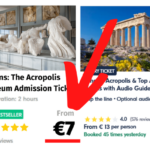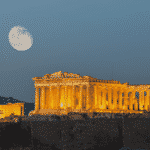Hey there! Have you ever heard about the Temples of Apollo? These aren’t old ruins, they’re gateways to understanding the rich history and culture of ancient Greece. Let’s take a closer look at these incredible places and find out why they are so important.
Why Are Apollo’s Temples So Special?
Apollo was a big deal in ancient Greece. He was the god of the sun, music, and prophecies, among other things. Imagine having a god who could play a killer tune and tell the future! That’s why the Greeks built so many temples in his honor. Here are a few reasons why these temples are worth talking about:
- Cultural Hotspots: Apollo’s temples were not places for prayer, they were the heart of culture, art, and society in ancient Greece.
- Architectural Wonders: Have you ever seen those postcards with stunning columns against a backdrop of blue skies? Yep, that’s the classic look of Apollo’s temples.
- Centers of Prophecy: Places like Delphi were ancient versions of a fortune-telling cafe, where people would go to hear predictions.
A Quick Tour of Apollo’s Famous Temples
Let’s jump on an imaginary tour bus and check out some of Apollo’s top temples. Buckle up!
- Delphi: This was the superstar temple where the famous Oracle would dish out prophecies. It was like the ancient world’s version of a spiritual advisor.
- Naxos: Picture a giant doorway to nowhere on a picturesque island. That’s the Temple of Apollo in Naxos, partly unfinished but Instagram-worthy.
- Corinth: Standing tall in the bustling city, the Temple of Corinth was a place where people gathered for worship and socializing.
- Epicurius: Hidden away in the mountains, this temple is a bit of a secret gem. It’s for those who love a good adventure off the beaten path.
- Pompeii: Yep, even the Romans were into Apollo. The temple in Pompeii shows how his worship spread far and wide.
What’s the Big Deal with These Temples?
So, why do we still care about these old stones? Well, they teach us a lot about what was important to people thousands of years ago. They show how daily life intertwined art, architecture, and religion. Plus, they’re a reminder of the incredible skills and vision of ancient builders and artists. But there’s more:
- They’re a Bridge to the Past: Walking through the remains of Apollo’s temples, you can almost hear the echoes of ancient ceremonies and feel the buzz of ancient festivals.
- They Inspire Us: Seeing what people created with the technology they had back then pushes us to think about what we can achieve today.
- Linking Us to the Natural World: Many of Apollo’s temples are set in breathtaking locations that show the deep connection the ancients had with the world around them.
So, Why Should You Care?
Now, you might be thinking, “Cool story, but ancient history isn’t my thing.” That’s fine, but here’s the thing – these temples are more than history. They’re about people, creativity, and the enduring human spirit. They remind us that, like us, people back then were trying to make sense of the world and leave their mark.
Plus, imagine the bragging rights you’d have after exploring these ancient wonders! You might be into history, architecture, or an epic adventure. Apollo’s temples have something for each.
Let’s Wrap It Up
The Temples of Apollo aren’t relics of the past. They’re timeless monuments to human ingenuity and devotion. They invite us to explore, learn, and feel inspired. So, next time you’re daydreaming about your next vacation or diving into a history book, why not take a moment to appreciate these ancient marvels? Who knows, maybe one day you’ll walk through their columns and feel the magic for yourself!
Remember, history isn’t about dates and facts. It’s about connecting with the stories and achievements of those who came before us. And who knows? Maybe their stories will inspire you to write your own.
The Story Behind Apollo’s Temples: What’s the Big Deal?
Have you ever wondered why there are so many temples dedicated to Apollo scattered across Greece and beyond? Let’s dive into the fascinating history of these ancient marvels and find out what made them so special.
Why Were Apollo’s Temples Built?
Imagine stepping back in time, when the world was full of mysteries, and people turned to gods for answers. Apollo, the god of light, music, and prophecy, was a big deal in ancient Greece. People built temples in his honor to get closer to him, seeking guidance and protection.
How Did These Temples Look Like?
You’ve probably seen pictures of ancient ruins with big columns and thought, “Wow, that’s pretty cool!” Those are the remains of Apollo’s temples. They used a simple yet striking style called Doric. Picture this: massive stone columns, standing tall and strong, holding up the roof. These temples were not just buildings; they were works of art.
Where Can You Find These Temples?
Apollo must have been quite the popular god because you can find his temples all over the place! Let’s take a quick tour:
- Delphi: This was like the ancient version of a psychic hotline. People came from far and wide to hear the oracle’s prophecies.
- Bassae: Hidden up in the mountains, this temple is a bit of a hike, but it’s worth it for the view.
- Corinth: Right in the city’s heart, this temple was a busy spot for worshipers.
- Epicurius: This one’s a bit of a mystery, tucked away in a remote area, making it even cooler to explore.
- Thermon: Not as famous as the others, but it has its unique charm.
What Made These Temples So Important?
Apart from being architectural masterpieces, Apollo’s temples were cultural hotspots. They were places where people could gather, celebrate festivals, and participate in sports events. Getting a prophecy from the Oracle of Delphi was like getting a sneak peek into your future. Pretty neat, right?
So, Why Should We Care Today?
You might be thinking, “Cool story, but what does it have to do with me?” Well, these temples teach us a lot about the ancient Greeks’ beliefs, their love for beauty, and their architectural genius. Plus, they remind us of the power of faith and how it shaped civilizations.
Next time you see a picture of those iconic columns, remember, there’s a whole world of history and mystery behind them. Who knows, maybe you’ll get to visit one of Apollo’s temples one day and feel the magic for yourself!
Discovering the Architectural Wonders of Apollo’s Temples
Ever stood in front of a building and thought, “Wow, how did they do that?” Well, Apollo’s temples are those kinds of places. Let’s dive into what makes these ancient sites so cool.
What’s With the Different Styles?
When it comes to ancient temples, not all are equal in creation. They came in different styles. Ever heard of Doric, Ionic, and Corinthian? These aren’t fancy words, they describe the styles of columns you’d find in Apollo’s temples. Let’s break it down:
- Doric Columns: Imagine a sturdy, no-nonsense kind of column with simple, clean lines. That’s Doric for you. It’s like the strong, silent type of the column world.
- Ionic Columns: These columns are a bit more on the fancy side, with scrolls at the top. Think of them as the elegant, more decorative cousins of the Doric columns.
- Corinthian Columns: Now, if Ionic columns are fancy, Corinthian columns are over-the-top extravagant. They’re decked out with elaborate leaves and scrolls, truly a sight to behold.
Cool Features to Look Out For
Apollo’s temples didn’t just stop at impressive columns. They had some other neat features:
- Friezes: These are the decorative bands that run across the top of the temple walls, often filled with carvings of battles, myths, or everyday scenes. It’s like an ancient comic strip telling stories in stone.
- Metopes: Found between the triglyphs in Doric friezes, these square panels were carved with all sorts of images, from heroic deeds to mythical adventures.
Spotlight on Some Architectural Marvels
- Bassae Frieze: Hidden away in the Temple of Apollo Epicurius, this frieze is a spectacular showcase of ancient art and storytelling.
- Delphi Theater: Close to Apollo’s temple in Delphi, this theater is a masterpiece of ancient engineering, offering stunning views and acoustics.
- Corinth Artifacts: The ruins at Corinth give us a peek into the architectural innovations that were part of Apollo’s worship site.
- Epicurius Engineering: The Temple of Apollo Epicurius is a blend of architectural styles, standing as a testament to the ingenuity of its creators.
Why Do These Architectural Styles Matter?
You might be wondering, “Okay, cool columns and carvings, but why should I care?” Well, these styles tell us a lot about the people who built them and the times they lived in. Each style reflects a different era and taste. They also reflect different technology. Here’s why they’re a big deal:
- Cultural Snapshot: The architectural styles of Apollo’s temples give us a glimpse into the values and aesthetics of ancient societies. Doric’s simplicity, Ionic’s elegance, and Corinthian’s extravagance each tell a story. They show what those people admired and aspired to.
- Engineering Feats: Building these temples wasn’t easy. Imagine lifting those massive columns without modern machinery! Each temple stands as a testament to the ancient builders’ skills and ingenuity.
- Artistic Expression: The friezes and metopes are not just decorations, they’re high art. They tell us about the myths, heroes, and daily life of ancient Greece, serving as a visual history lesson.
So, What’s the Takeaway?
Next time you see a photo or movie with Greek columns, you’ll know there’s more than meets the eye. Apollo’s temples are masterclasses in architecture, engineering, and art all rolled into one. They show us how ancient Greeks expressed their devotion to their gods. They also showed their community identity and their artistic and engineering skill.
You may be an architecture buff, a history enthusiast, or someone who appreciates cool old buildings. The temples dedicated to Apollo have something for you. They remind us that our ancestors were much like us. They reached for the divine, celebrated beauty, and pushed the limits of what’s possible.
The next time you see a column, a frieze, or a metope, remember the stories, the skills, and the hard work that went into making them. Who knows, maybe they’ll inspire you to create something wonderful too!
Unveiling the Spiritual Heart of Apollo’s Temples
Have you ever wondered what made Apollo’s temples special? They were not just great buildings, but also hubs of ancient spirituality and community. Let’s get up close with the religious practices, rituals, and festivals. They breathed life into these sacred spaces.
The Oracle of Delphi: Apollo’s Voice to the World
- Who Was the Oracle? Picture a priestess, known as the Pythia, sitting in a sacred chamber, ready to channel Apollo’s wisdom. People from all corners of the ancient world would come seeking answers.
- How Did It Work? The Pythia would enter a trance-like state (thanks to some mysterious vapors) and utter prophecies. These were then interpreted by the priests to the seekers – a divine guidance hotline if you will.
Festivals and Games: Celebrating Apollo
Apollo wasn’t just about doom and gloom prophecies, his temples were also places of joy and celebration.
- Apollo Festivals: Imagine the ancient version of a music and arts festival. There were music, poetry, and athletics competitions. They were all dedicated to Apollo and showcased his influence on arts and sports.
- Pythian Games: Like the Olympics, these games held at Delphi were a big deal. Athletes and artists would compete for glory, all in honor of Apollo.
- Rituals and Ceremonies: Connecting with the Divine
- Daily Offerings and Prayers: Each day, devotees would bring offerings and say prayers at Apollo’s temples. It was a way to seek favor, express gratitude, or ask for guidance.
- Special Ceremonies: People held special ceremonies, from animal sacrifices to elaborate processions, to commemorate significant events or seek Apollo’s intervention in times of crisis.
The Omphalos Stone: Navel of the World
What’s This Stone About? In Delphi, people believed that the Omphalos Stone marked the center of the earth. It symbolized Delphi’s importance as the spiritual heart of the ancient Greek world.
- Why It Matters: The stone was more than a landmark, it was a powerful symbol of Apollo’s presence and the sacredness of Delphi.
Why Were These Practices So Important?
You might be thinking, “Okay, cool stories, but why did they matter so much?” Here’s the thing:
- Community Bonding: These events were festivals, games, and ceremonies. They brought people together and created a sense of community and shared identity.
- Spiritual Guidance: In a world without Google or GPS, divine guidance from the oracles was the next best thing. People sought answers to life’s big questions from Apollo through the Pythia.
The rituals and celebrations at Apollo’s temples left a lasting impact on Western culture. They influenced literature, art, and our view of sports and festivals today.
So, What’s the Takeaway?
Apollo’s temples were not just stone structures. They were vibrant centers of worship, celebration, and community. The rituals and festivals honor Apollo. They show the deep spiritual and cultural importance of these ancient sites.
They remind us of the human desire to connect with something greater than us. We seek beauty and meaning in life’s mysteries. Next time you hear about Apollo or see his temples in photos, remember the rich tapestry of religious practices. And the communal celebrations that once thrived within those ancient walls.
Discovering the Marvels of Apollo’s Temples Around the World
Have you ever wanted to time-travel and explore ancient wonders? Well, you’re in luck! Let’s go on a journey to find some of the most important temples. They dedicate themselves to Apollo, the god of the sun, music, prophecy, and healing. These ancient sites are not just piles of rocks. They provide a glimpse into the past as storied places.
The Oracle’s Home: Temple of Apollo at Delphi
- Why It’s Famous: Delphi is like the ancient world’s version of a spiritual center. The Temple of Apollo here was home to the famous Oracle of Delphi, where people from all over came for guidance.
- What to Look Out For: Don’t miss the Delphi Charioteer. It’s one of the most notable statues from ancient Greece. It shows the art that adorned this sacred place.
The Gateway to the Gods: Temple of Apollo at Naxos
- Why It’s Special: Imagine walking through a massive marble gateway, the Portara, that leads to nowhere and everywhere at the same time. That’s the entrance to the unfinished Temple of Apollo at Naxos.
- Unique Features: The Naxos Gate stands as a testament to ambitious construction. But, it was never finished. Yet its beauty and mystery draw visitors from around the world.
A Blend of Might and Art: Temple of Apollo Epicurius
- What makes it unique is that it sits in the mountains of the Peloponnese. The Temple of Apollo Epicurius at Bassae is a UNESCO World Heritage site known for its mix of architectural styles.
- Architectural Wonders: This temple combines Doric, Ionic, and even Corinthian elements. It shows how Greek temple design evolved. It’s a must-see for architecture enthusiasts.
The City’s Pride: Temple of Apollo at Corinth
- Historical Significance: The temple was in Corinth, an ancient city. It was a beacon of the city’s religious and social life.
- Treasures to Discover: The ruins at Corinth still hold treasures like the Corinthian Treasures, which give us a peek into the wealth and artistic achievements of ancient Corinth.
Why Visit These Temples?
Walk Through History: Visiting these temples lets you walk in the footsteps of ancient pilgrims, athletes, and artists. You can also follow the path of everyday folks who once gathered at these sites.
- Marvel at Ancient Engineering: The ancients achieved great architectural feats without modern technology. Their achievements are astounding. From towering columns to intricate carvings, each temple showcases the ingenuity of its creators.
- Connect with the Past: Each temple tells a story of devotion, community, and the human desire to reach for the divine. They remind us of our shared history and the timeless quest for meaning and beauty.
So, Why Should These Temples Matter to You?
Think of these temples as portals to a bygone era. Myths walked hand in hand with mortals and the gods played a key role in daily life. They are not just historical sites. They are places where you can feel the awe and wonder that captivated humans for centuries.
- Inspiration for Modern Minds: In our fast, digital world, these old temples remind us of the lasting power of faith, community, and art. They inspire us to appreciate the beauty around us and to remember the past as we look to the future.
- A Call to Adventure: Do you love history or architecture? Or are you in search of inspiration? The temples of Apollo offer a unique journey. Explore, learn, and be amazed – they invite you to do so.
Ready to pack your bags and embark on this ancient adventure? The temples of Apollo await to tell you their timeless tales. They whisper secrets of the past and inspire you with their enduring beauty. Who knows what mysteries you’ll find? What stories will unfold as you walk among these old marvels?
Preserving History: The Journey of Apollo’s Temples into Today
Curious about how ancient temples stand the test of time? Let’s explore the fascinating world of Apollo’s temples. We will focus on their conservation and their role in modern tourism. These majestic ruins are not just remnants of the past, they are living stories that continue to captivate and inspire.
The Herculean Task of Conservation
Keeping Apollo’s temples standing tall isn’t an easy feat. It’s a blend of science, art, and dedication. Here’s how experts are ensuring these ancient wonders remain for generations to come:
- Restoration Projects: From fixing crumbling columns to preserving ancient carvings, restoration efforts breathe new life into these historic sites.
- UNESCO World Heritage Sites: Many of Apollo’s temples, like the one at Delphi, are recognized by UNESCO, ensuring they receive the protection and attention they deserve.
- Combating the Elements: Facing everything from earthquakes to pollution, conservationists are the unsung heroes who battle to protect these temples from the ravages of time and nature.
The Thrill of Visiting Apollo’s Temples
Imagine walking in the footsteps of ancient Greeks, or standing where oracles once divined the future. Visiting Apollo’s temples is a bucket-list experience for many, and here’s why:
- Guided Tours: Knowledgeable guides bring the history of these temples to life, sharing stories and secrets that you won’t find in any textbook.
- Museum Visits: Adjacent museums, like the Delphi Museum, offer a deeper dive into the artifacts and history surrounding Apollo’s worship.
- Accessibility Efforts: Efforts are being made to ensure that more people can experience these sites firsthand, from improved pathways to virtual tours for those who can’t travel.
The Impact of Tourism: A Double-Edged Sword
Tourism brings both benefits and challenges to Apollo’s temples. On one hand, it’s an essential source of funding for preservation efforts. On the other, too many visitors can lead to wear and tear on these ancient structures.
- Promoting Responsible Tourism: Encouraging visitors to respect these sacred sites helps ensure they’ll remain standing strong.
- Balancing Access with Preservation: Finding the sweet spot between welcoming tourists and protecting the temples is an ongoing challenge for conservationists.
Why Apollo’s Temples Matter Today
So, why should we care about preserving and visiting these ancient sites? It’s simple:
- Cultural Heritage: Apollo’s temples are treasures of human history, offering insights into ancient civilizations that shaped the world as we know it.
- Educational Value: They provide a tangible connection to the past, enriching our understanding of history, architecture, and mythology.
- Inspiration for the Future: These temples remind us of what humanity can achieve, inspiring new generations to appreciate and preserve our shared heritage.
Ready to Explore?
Visiting Apollo’s temples offers a unique blend of adventure, history, and reflection. You might marvel at the cleverness of our ancestors. Or ponder the mysteries of the ancient world. These sites are a testament to the enduring human spirit. So, why not add them to your travel list and experience their magic for yourself?
We walk through these old halls and stand under the open skies where oracles once spoke. Remember, we’re not just tourists – we’re keepers of history. We must ensure that we continue telling the story of Apollo and his temples for generations to come.
Unraveling the Mysteries of Apollo: The Multifaceted God of Ancient Greece
Have the tales of ancient gods and heroes ever captivated you? Apollo is among the most intriguing of these divine figures. He is known for his great powers and many roles in Greek mythology. Let’s dive into the world of Apollo and discover why he was so important to the ancients.
Who Was Apollo?
Apollo was not just any god, he was a jack-of-all-trades in the divine world. Here are some of the hats he wore:
- God of Light: Ever enjoyed the warm glow of the sun on your face? You can thank Apollo for that. He was often associated with the sun, bringing light and warmth to the earth.
- Master of Music: Apollo was also a rock star of his time. With his trusty lyre, he created beautiful music that could soothe even the wildest of beasts.
- The Prophet: As the god of prophecy, Apollo had the power to reveal the future. The famous Oracle of Delphi was his spokesperson. People went there to get answers to their urgent questions.
Apollo’s Epic Origins and Adventures
- A Divine Birth: Apollo’s entrance into the world was nothing short of dramatic. Apollo was born on the island of Delos to Zeus, the king of gods, and Leto, a Titan goddess. Apollo and his twin sister Artemis showed their divine power from a young age.
- Battling the Python Dragon: One of Apollo’s first heroic feats was killing the Python. It was a monstrous dragon that terrorized Delphi. This act established him as a protector and led to the founding of the Pythian Games in honor of his victory.
Apollo’s Relationships: A Complicated Love Life
A Heartbreaker: Apollo’s love life was as complex as his portfolio of powers. Apollo chased the nymph Daphne. She turned into a laurel tree to escape him. He also pursued the mortal princess Cassandra. His romantic pursuits often ended in tragedy.
The Symbols of Apollo: More Than Decorations
Each symbol associated with Apollo tells a part of his story:
- The Lyre: Representing his love for music, the lyre symbolizes harmony and artistic inspiration.
- The Sun Chariot: Apollo’s daily ride across the sky in his sun chariot brought light to the world.
- The Laurel Wreath: After Daphne became a laurel tree, Apollo made a wreath from her branches. It symbolized eternal glory and victory.
Why Apollo Still Captivates Us Today
So, why does Apollo’s story matter to us now? Here are a few reasons:
- A Source of Inspiration: Apollo’s tales of courage, creativity, and resilience continue to inspire art, music, and literature around the world.
- Lessons in Humanity: Apollo’s triumphs and failures teach us about life’s complexity. They also show the value of pursuing our passions.
Ready to Explore More?
The myths of Apollo are fascinating. They offer a glimpse into the values, fears, and hopes of ancient Greek society. You may be a mythology buff or curious about the past. Apollo’s adventures remind us of the power of storytelling. It connects us across time and cultures.
The next time you sit in the sunlight or feel moved by music, remember Apollo. Remember the rich tapestry of myths that shape our world. Who knows what other lessons and inspirations you might find in the tales of this god?
Apollo vs. The Pantheon: A Look at Greek Temples
Have you ever wondered how Apollo’s temples compare to those of other Greek gods? I mean gods like Zeus, Athena, and Artemis. Let’s compare these divine dwellings. We’ll see how they differ in architecture, location, and cultural importance. What sets them apart and what they have in common might surprise you!
Architectural Styles: The Divine Details
Do you know that Greek temples’ stunning architecture tells us a lot? It tells us about the deity to whom people dedicated them.
- Apollo’s Temples: Often found in the Doric and Ionic styles, Apollo’s temples reflect his nature as both a warrior and a patron of the arts. The Temple of Apollo at Delphi has sturdy, simple Doric columns. The Temple of Apollo Epicurius blends Doric, Ionic, and Corinthian elements. It shows Apollo’s many sides.
- Zeus’s Temples: People built grand temples like the one in Olympia to honor Zeus, the king of the gods. The Temple of Zeus showcased the Doric style, emphasizing his strength and authority.
- Athena’s Parthenon: Dedicated to the goddess of wisdom and warfare, the Parthenon on the Athenian
Acropolis is a masterpiece of the Doric order, though it also incorporates Ionic elements in its interior. Its sophisticated design reflects Athena’s wisdom and strategic mind. - Artemis’s Temple: The Temple of Artemis at Ephesus was one of the Seven Wonders of the Ancient World, Ionic in style. This grand temple honored Artemis’s role as a huntress and protector of the wild.
Location, Location, Location: Where the Gods Live
The locations of these temples tell a story. They show which gods the temples honored and how important the gods were to ancient Greek society.
- Apollo: Apollo’s temples were often located in places of stunning natural beauty or strategic importance. For example, the ancient Greeks considered Delphi as the navel of the world. This idea emphasized Apollo’s key role in their religion and culture.
- Zeus: The Temple of Zeus at Olympia was in a sanctuary that hosted the Olympic Games. This reflected Zeus’s status as a patron of athletes and a symbol of unity among the Greek city-states.
- Athena: The Parthenon, sitting high on the
Acropolis of Athens, symbolizes Athena’s role as the protector of the city and its patron goddess. Its prominent location underscores her importance to Athens’s identity. - Artemis: The temple was at Ephesus near the coast. Worshippers from across the Greek world could get to it. Its location highlights Artemis’s widespread worship and the temple’s role as a major pilgrimage site.
Cultural Significance: More Than Just Buildings
Each temple served not as a religious center but also as a reflection of the god’s role in Greek life and mythology.
- Apollo’s Temples: Sites of music, healing, and prophecy, Apollo’s temples were centers of culture and knowledge, where people sought divine guidance and celebrated the arts.
- Zeus’s Temple at Olympia: This temple was a unifying symbol for the Greek world, bringing together city-states in competition and worship during the Olympic Games.
- The Parthenon: More than just a temple, the Parthenon was a statement of Athenian power and a tribute to Athena’s protection and wisdom during the Persian Wars.
- The Temple of Artemis: A testament to Artemis’s dual nature as a huntress and protector, her temple served as both a sanctuary and a significant economic and cultural hub.
Wrapping Up: A Divine Comparison
Each Greek god had a unique flavor. Their temples reflect that diversity. The architectural styles and locations reflect their cultural roles. Apollo’s blend of arts and prophecy may draw you in. Or, to Zeus’s strength, Athena’s wisdom, or Artemis’s wild nature. Exploring these ancient temples offers a glimpse into Greek mythology and religion. They show a rich tapestry.
Next time you marvel at ancient ruins. Or, plan a mythological road trip through Greece. Remember the stories these temples tell and the gods they honor. Who knows what divine secrets and historical treasures you’ll uncover?
Embracing the Future: How Technology Revolutionizes the Preservation of Apollo’s Temples
Isn’t it amazing how technology can take us back in time? Let’s explore cutting-edge tools and methods. They are breathing new life into Apollo’s ancient temples. These advancements aren’t cool gadgets. They’re changing how we understand, experience, and save history.
3D Laser Scanning: A Game-Changer in Archaeology
Ever wished you could capture every detail of a historic site in a snapshot? That’s where 3D laser scanning comes in:
- Precision at Its Best: This technology creates accurate 3D models of temples. It captures every nook and cranny without touching a single stone.
- Unveiling the Invisible: Laser scans can reveal details the naked eye can’t see. They show worn inscriptions and hidden architecture.
Virtual Reality: Step into the Ancient World
Imagine slipping on a VR headset and standing in the midst of a bustling ancient temple. Virtual reality makes this possible:
- A Time Machine on Your Head: Virtual tours take you back to the temples in their prime. They show vibrant rituals and daily activities.
- Accessible History: VR opens up these historic sites to the world, allowing anyone, anywhere, to explore them without leaving their home.
Digital Reconstruction: Rebuilding the Past, Pixel by Pixel
- Piecing Together History: Digital reconstructions use data from excavations, old texts, and artifacts. They use it to recreate temples as they once were.
- A New Perspective: These digital models offer insights into the cleverness of ancient builders. They also show how these sacred sites changed over time.
The Impact of Technology on Archaeological Preservation
So, what does all this tech mean for the preservation of Apollo’s temples? Here’s the rundown:
- Conservation Without Damage: Non-invasive techniques like 3D scanning mean we can study and preserve these sites without risking harm to their ancient structures.
- A Richer Understanding: Technology helps archaeologists and historians uncover new information about the construction, use, and significance of these temples.
- Bringing History to Life: For the public, VR tours and digital reconstructions make ancient history engaging. They make it immersive and accessible.
Why This Matters
You might be thinking, “Cool tech, but why should I care?” These technologies are not reshaping archaeology. They’re changing how we connect with our past. They ensure that Apollo’s temples will last for future generations to discover. The temples hold stories for them to marvel at.
- Inspiring Curiosity: By making ancient history interactive and accessible, technology encourages us to learn more about our shared heritage.
- Preserving for Posterity: These temples face threats from decay and humans. But, technology offers new ways to save them.
Ready to Explore?
Thanks to these technological advances, the ancient world of Apollo and his temples is a click or a headset away. Are you a history buff, a tech enthusiast, or curious about the past? There has never been a better time to explore the wonders of ancient Greece. So, why not dive in and see where history (and technology) can take you?
Bringing the Past to Life: Interactive Experiences at Apollo’s Temples
Have you ever wished you could step back in time and witness the glory of ancient Greece firsthand? Thanks to modern technology and new education efforts, visiting Apollo’s temples can now be an immersive journey. It goes far beyond looking at ruins and imagining the past. Let’s explore how interactive experiences are revolutionizing our connection with these ancient sites.
Step Into the Ancient World with Augmented Reality (AR)
What’s AR? Imagine wearing glasses and suddenly seeing ancient temples. Right before your eyes, you can see them restored to their original glory. That’s augmented reality – a technology that overlays digital images onto the real world.
- AR Temple Tours: Several sites offer AR experiences. You can see the temples of Apollo as they looked thousands of years ago. Walk through the sanctuary of Delphi or the ruins of Naxos, and watch history come alive.
Get Your Hands Dirty with Workshops
Who says history has to be all lectures and no fun? Apollo’s temples are inspiring hands-on workshops where you can learn ancient crafts and skills.
- Greek Pottery Workshop: Have you ever admired Greek vases and wondered how people made them? Now’s your chance to try it yourself. The workshops teach you the methods of ancient artisans. You get to make your own piece of history.
- Mythology Lectures: Dive deep into the tales of Apollo. Learn about his mighty deeds and his divine family through talks and discussions. It’s like storytime, but for mythology buffs.
Digital Experiences: Explore from Anywhere
Not everyone can fly to Greece. But, digital tools let everyone explore Apollo’s temples, no matter where they are.
- Virtual Tours: Through 360-degree photos and videos, you can take a virtual stroll through these ancient sites. Some even offer guided tours. You have a knowledgeable companion the whole way.
- Digital Delphi Experience: Delphi was one of Apollo’s main sanctuaries. You can now explore it online. Interactive maps and digital reconstructions offer insights into the site’s layout and history. They also show the role it played in ancient Greece.
Why Interactive Experiences Matter
So, why should you check out these interactive experiences? Here are a few reasons:
- Educational Value: They provide a deeper understanding of ancient Greek culture, religion, and daily life, making learning fun and engaging.
- Accessibility: Digital and AR experiences allow people from all over the world to explore these sites, breaking down barriers of distance and physical ability.
- Preservation: By using these temples digitally, we cut foot traffic and wear on the sites. This helps to preserve them for future generations.
Ready to Explore?
Experiences at Apollo’s temples are interactive. They are changing how we connect with history. They make it more accessible, engaging, and educational. You may explore these ancient sites in person or from home. Now is the best time to dive into the world of ancient Greece.
So, what are you waiting for? Grab your virtual reality headset. Download an AR app or sign up for a workshop. Prepare to embark on an unforgettable journey back in time. Who knows what insights and inspirations you’ll discover along the way?
The Enduring Legacy of Apollo’s Temples in Art and Culture
Have you ever noticed how some ancient symbols seem to pop up everywhere, from movies to your favorite paintings? Apollo’s temples are just like that – they’ve been inspiring creativity for centuries. Let’s dive into how these architectural marvels have left their mark on art, literature, and even modern buildings.
Apollo in the Renaissance: A Revival of Beauty
- Artistic Inspiration: During the Renaissance, artists and scholars looked back to the classical world for inspiration. Apollo’s temples, with their perfect proportions and harmony, became symbols of beauty and balance.
- Famous paintings and sculptures often featured Apollo. They showed temples in the background as symbols of divine inspiration and classical perfection.
Romantic Poetry: Echoes of Ancient Ruins
- A Muse for Poets: The Romantic poets were all about expressing deep emotions and a love for nature. The ruins of Apollo’s temples stand silently among wildflowers and rugged landscapes. They served as perfect muses.
- Lord Byron wrote passionately about Greek ruins. They included temples dedicated to Apollo. He saw them as poignant reminders of the past’s grandeur and the fleeting nature of human achievements.
Contemporary Architecture: Bridging the Past and Present
- Neoclassical Influences: Have you ever walked by a building and felt as if it transported you to ancient Greece? That’s the magic of neoclassical architecture, which borrows from the designs of Apollo’s temples.
- Many modern buildings have Doric columns and pediments. People find them in places ranging from museums to government buildings. They are a nod to the lasting influence of Apollo’s sacred spaces.
The Symbolic Significance of Apollo’s Temples
Apollo’s temples are more than stones and columns. They hold stories and are symbols of the human quest for knowledge, beauty, and harmony. They remind us of the ancient connection to the divine and the eternal search for meaning.
- Cultural Impact: These ancient temples have shaped not the land. They have also shaped our culture, influencing art, literature, philosophy and science.
- Artistic Representation: Apollo’s temples inspire a dialogue through paintings, poetry, and architecture. They challenge us to reflect on our place in the world and our links to the ancient past.
Why Apollo Still Matters
The world often feels disconnected from its roots. The legacy of Apollo’s temples offers a bridge to the past. They remind us of the enduring human spirit and our ceaseless pursuit of beauty and truth.
- A Source of Inspiration: For artists, writers, and architects, these old ruins are a wellspring of creativity. They push the bounds of imagination and innovation.
- A Cultural Touchstone: For the rest of us, they remind us that the past is always here. It shapes how we see and understand our place.
So, the next time you come across a reference to Apollo or his temples, take a moment to consider the vast web of cultural, artistic, and historical links they show. Who knows? You might find yourself inspired to create something beautiful, too.
The Global Legacy of Apollo’s Temples: A Cultural Odyssey
Have you ever wondered how the worship of a Greek god, like Apollo, crossed oceans and reached distant lands? The spread of Apollo’s cult and its temples beyond the Greek mainland is a tale of cultural exchange. It includes architectural innovation and religious adaptation. Let’s embark on a journey to explore the global legacy of Apollo’s temples.
Apollo’s Worship Beyond Greece
Apollo’s influence wasn’t confined to Greece. Many worshiped him. They did so from the sunny shores of the Mediterranean to the busy streets of Rome and beyond. How did this happen, you ask?
- Cultural Exchange: The Greeks traded and interacted with other civilizations. They introduced worship of Apollo to new lands.
- Roman Adoption: The Romans, fascinated by Greek culture, adopted Apollo into their pantheon, building magnificent temples in his honor.
Architectural Fusion in Temples Outside Greece
The temples dedicated to Apollo outside Greece are marvels of architectural fusion. They blend Greek design principles with local styles. This creates unique structures that reflect a mix of cultures.
- Roman Temples of Apollo: In places like Pompeii, Apollo’s temples showcased Roman engineering prowess with Greek architectural aesthetics, featuring grand columns and elaborate friezes.
- Anatolian Sanctuaries: In Anatolia, Apollo’s sanctuaries used local religious architecture. They stood as proof of the cultural mixing between Greek settlers and native people.
Apollo’s Role in the Pantheon of Roman Gods and Beyond
Apollo’s integration into the Roman pantheon highlights the god’s versatility and universal appeal. But what made Apollo so attractive to the Romans and other cultures?
- The God of Many Faces: Apollo’s domains—music, prophecy, healing—resonated with diverse cultures, making him a multifaceted deity who could be worshipped in various aspects.
- A Symbol of Imperial Power: For the Romans, Apollo represented divine approval for their empire’s growth. He was often shown as a god who favored Rome.
The Impact of Apollo’s Temples on Local Cultures and Religious Practices
The spread of Apollo’s worship influenced local cultures globally. It deeply affected their religions.
- Cultural Fusion: Apollo’s temples became centers where Greek and local traditions mixed. This led to the creation of mixed cultural identities.
- Architectural Inspiration: The design of Apollo’s temples inspired local architects, who incorporated Greek elements into their work, enriching their architectural heritage.
The Enduring Influence of Apollo’s Temples
Today, the remnants of Apollo’s temples across the world stand as monuments to the god’s enduring legacy. They remind us of the power of cultural exchange. Art, architecture, and religion can unite diverse peoples. They can transcend boundaries.
- A Legacy Carved in Stone: Whether in the ruins of Pompeii or the sanctuaries of Anatolia, Apollo’s temples still inspire awe and curiosity. They draw visitors from around the globe.
- A Testament to Syncretism: Apollo’s temples show the global legacy of blending. They also show the changeability of religious worship and the unity of ancient cultures.
So, the next time you marvel at the ruins of an ancient temple for Apollo, remember this. You’re witnessing a chapter in a story of cultural exchange, adaptation, and innovation that is thousands of years old. Apollo’s temples are not relics of the past. They are living symbols of humanity’s shared heritage. They represent the timeless quest for beauty and understanding.
Your Ultimate Guide to Visiting Apollo’s Temples
Planning a trip to explore the ancient temples dedicated to Apollo? You might be a history buff, a culture enthusiast, or just in search of awe-inspiring sights. Visiting these ancient marvels is a journey back in time. Here’s everything you need to know to make your visit unforgettable.
When to Visit: Timing Is Everything
Choosing the right time to visit can make all the difference in your experience. Here’s what to consider:
- Avoid the Crowds: Early spring and late autumn are perfect, offering mild weather and fewer visitors.
- Best Time of Day: Try to get there early in the morning or later in the afternoon to avoid the midday sun and tour groups.
Tickets and Accessibility: Planning Ahead
Being prepared can help you avoid any hiccups during your visit. Let’s break it down:
- Ticket Prices: Check the official site or call ahead for the most current ticket prices. for students, people older than 65, and children.
- Accessibility: While ancient sites can be challenging, many have made efforts to improve accessibility. Check in advance for specific accommodations like ramps or special tours.
Making the Most of Your Visit: Insider Tips
To ensure your visit is as enriching as it is exciting, keep these tips in mind:
- Guided Tours: Opting for a guided tour can offer deeper insights into the history and mythology of Apollo’s temples.
- Cultural Etiquette: Respect the sites by following posted rules, speaking softly, and dressing appropriately..
- Conservation Efforts: Show your support by staying on marked paths, not touching the ruins, and considering a donation to preservation efforts.
Nearby Attractions: Beyond the Temples
Apollo’s temples are often located in areas rich in history and natural beauty. Explore nearby attractions to enhance your trip:
- Delphi: Besides the Temple of Apollo, don’t miss the Delphi Archaeological Museum and the scenic mountain trails.
- Naxos: After visiting the iconic Portara, enjoy the island’s stunning beaches and charming villages.
- Corinth: Explore the ancient city, the Acrocorinth fortress, and the nearby Corinth Canal.
Before You Go: A Few Last Tips
To ensure your visit is smooth and enjoyable, here are a few final pieces of advice:
- Stay Hydrated: Bring water, especially during warmer months, as ancient sites often have limited shade.
- Wear Comfortable Shoes: Be prepared for uneven terrain and a lot of walking.
- Capture the Moment: Photography is usually allowed. But, always check for restrictions, especially on using flash.
Conclusion: A Journey Worth Taking
Visiting Apollo’s temples is more than a trip. It’s an experience that connects you to human history, art, and spirituality. You have the right information and a sense of adventure. You’re all set to explore these ancient wonders and make memories that will last a lifetime. Safe travels, and may Apollo’s light guide your way!
 Before you buy tickets, read the guide for 2024. Click Here
Before you buy tickets, read the guide for 2024. Click Here
